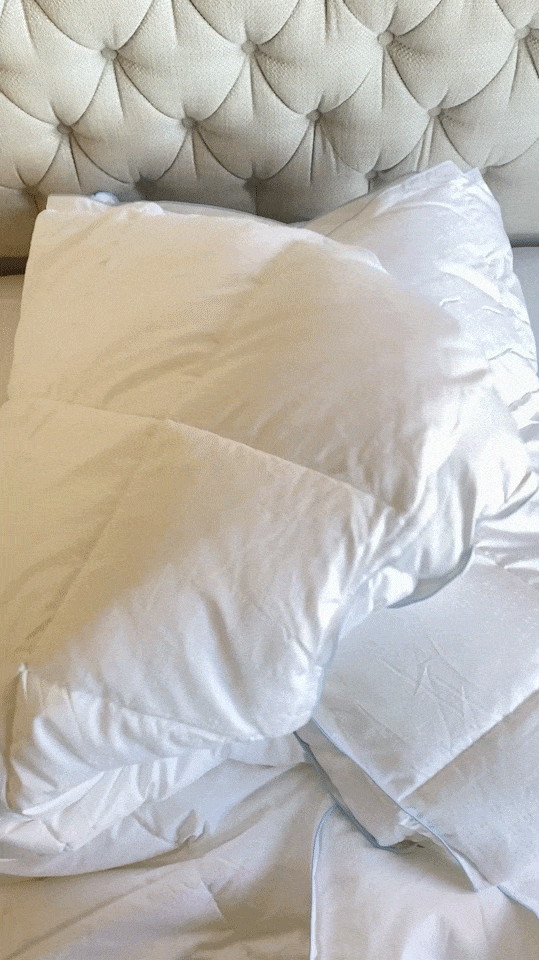The Ultimate Duvet Guide
Everything You Need to Know about Duvets
Discover Luxuriously Dreamy Duvets
A duvet is the heart of a cosy bed, providing comfort and warmth through every season. Whether you need a lightweight duvet for summer, a snug option for winter, or an all-season solution, finding the right duvet can transform your sleep quality. This guide breaks down everything you need to know about duvet types, fillings, sizes, and tog ratings to help you find your perfect duvet match.

The Fundamentals of Choosing the Right Duvet
The perfect duvet combines key elements like fillings, tog ratings, size, and material, tailored to your personal preference. The right duvet enhances sleep quality by regulating body temperature and reducing discomfort, helping you wake up refreshed and ready for the day.
The secret to choosing the perfect duvet lies in understanding its three core elements:
- Duvet Filling: Determines the insulation, weight, and overall feel of the duvet. Natural fillings like goose down, feather, silk, or wool offer warmth and breathability, while synthetic fillings like microfibre or hollowfibre provide hypoallergenic and low-maintenance when it comes to lasting.
- Fabric: The outer cover impacts the duvet’s breathability and how it feels against your skin. High-quality cotton is soft and breathable, while synthetic casings are durable and often budget-friendly.
- Tog Rating: Indicates the duvet’s warmth level. Lower tog ratings, such as 4.5 tog duvets, are ideal for summer, while higher ratings, like 13.5 tog duvets, provide cosy insulation for winter. All-season duvets like 9.5 or 10.5 combine layers for year-round versatility.
Everything You Need to Know About Duvet Fillings
The filling is the heart of your duvet. It determines its warmth, weight, and feel, playing a major role in your overall sleep comfort. From natural to synthetic options, each type of duvet filling offers unique benefits. Here’s a breakdown to help you find your perfect match.
Feather and down duvets are loved for their lightness, softness, and ability to trap heat without feeling heavy. They’re made from the soft underlayer of feathers, typically from geese or ducks, and offer a luxurious and lofty feel on your bed.
Popular Feather and Down Duvet Fillings
- Hungarian Goose Down Duvet: Hungarian goose down is widely recognised for its superior quality, thanks to the colder climate where these geese are raised. The down clusters are larger and fluffier, allowing them to trap air more efficiently, which creates excellent insulation. This unique structure makes Hungarian goose down duvets both lightweight and warm, perfect for year-round use.
- Siberian Goose Down Duvet: What makes Siberian goose down unique is its ability to keep you warm without adding weight. The down’s lightweight structure offers a cosy, cocoon-like feel, making it ideal for colder climates or those who enjoy a snug sleeping environment. It’s also highly breathable, preventing overheating while maintaining consistent warmth throughout the night.
- Canadian Goose Down Duvet: Canadian goose down is known for its outstanding quality and comfort. Sourced from geese raised in Canada’s cold climate, this down features large, fluffy clusters that provide excellent insulation without feeling heavy.This type of down is also highly durable, keeping its loft and softness over time. If you’re looking for a duvet that combines luxury, practicality, and long-lasting comfort, Canadian goose down is a fantastic choice.
- Edelweiss Hungarian Goose Down Duvet: Edelweiss Hungarian goose down is a step above regular Hungarian goose down. It’s made from carefully selected, larger down clusters that offer better warmth and softness. This duvet is cmade with extra care, making it durable, lightweight, and perfect for year-round use. Its hypoallergenic properties also make it a great option for those with sensitivities. Edelweiss Hungarian can be compared to royal standard duvet filling.
Synthetic duvets are a practical and affordable alternative to natural fillings. Designed to mimic the softness and comfort of down, they offer hypoallergenic properties and are easy to maintain, making them a great option for those with allergies or busy lifestyles.
Popular Synthetic Duvet Fillings
- Anti-Allergy Microfibre Duvet is made using ultra-fine synthetic fibres designed to mimic the softness and lightness of natural down. This duvet is a great choice for those with allergies, as it’s naturally hypoallergenic and resists common triggers like dust mites. The microfibre filling ensures a cosy and fluffy feel, making it comfortable for a wide range of sleepers. Easy to maintain, this duvet is machine washable, making it a practical option for everyday use while still providing excellent warmth and comfort.
- Pure Silk Duvet: Made from natural silk fibres, these duvets are breathable and excellent at regulating temperature. They help wick away moisture, keeping you cool during summer and warm in winter. Silk is gentle on the skin, making it an ideal option for people with allergies or sensitivities. While silk duvets require professional cleaning, their long-lasting quality and lightweight feel make them a valuable investment for anyone looking to upgrade their sleep experience.
Our Commitment to Ethical Duvet Practices
We take pride in maintaining transparency throughout our supply chain. From responsibly sourcing materials to adhering strictly to animal welfare standards, every step of our process reflects our dedication to quality, sustainability, and ethical practices. Whether it’s the down in our duvets or the natural silk and wool we use, we ensure that all materials are sourced responsibly, so you can sleep soundly knowing your comfort doesn’t come at a cost to the environment or ethical standards.
Duvet Sizes and Dimensions
Choosing the right duvet size is essential for a comfortable and restful night’s sleep. A well-fitted duvet ensures full coverage, reduces cold spots, and enhances your sleeping experience.
*Hack: When selecting a duvet, consider whether you prefer a snug fit or a little extra overhang for added warmth and aesthetic appeal. For example, opting for a super king duvet on a king bed can create a plush, hotel-like experience.
Here are the standard duvet sizes available, along with their dimensions in centimetres (cm):
Singe Duvets are great for single beds, offering adequate coverage for solo sleepers.
Double Duvets are ideal for double beds, providing ample room for two without feeling too heavy.
King Size Duvets are made for king-size beds, offering generous coverage to keep you cosy all night.
Superking Duvets are perfect for super king-size beds, providing luxurious coverage and extra comfort.
Understanding Duvet Tog Ratings
Duvet tog ratings measure a duvet’s ability to trap heat, helping you choose the right level of warmth for your comfort and the changing seasons. Selecting the right tog ensures a cosy and restful sleep, whether it’s summer, winter, or somewhere in between.
- 4.5 Tog (Lightweight):
Perfect for summer or for naturally warm sleepers, this lightweight duvet provides cool comfort without overheating. - 10.5 Tog (Midweight):
A versatile option suitable for year-round use in moderate climates. This tog strikes the perfect balance between warmth and breathability, making it a popular choice for most homes. - 13.5 Tog (Heavyweight):
Ideal for winter or colder environments, this tog provides superior insulation to keep you snug and warm during frosty nights. - All-Seasons Duvets:
A flexible option combining two duvets—typically a 4.5 tog and a 9 tog—that can be used individually or buttoned together for a combined 13.5 tog. This adaptable design allows you to customise your duvet for any time of the year.
How to Care for Your Duvets
Proper care is essential to keep your duvet fresh, clean, and comfortable for years. By following these simple steps, you can extend the life of your duvet and maintain its quality:
Daily Care
- Shake It Out: Fluff your duvet daily to keep the filling evenly distributed and maintain its loft.
- Air It Out: When changing your bedding, allow your duvet to air out for a few hours to release moisture and odours.
Washing Your Duvet
Different duvet fillings require specific care, so always check the care label before cleaning:
Down and Feather Duvets:
- Use a large-capacity washing machine to prevent overcrowding.
- Wash at 30–40°C on a gentle cycle with a mild detergent.
- Avoid fabric softeners, as they can coat the feathers and reduce loft.
- Dry thoroughly on low heat, using dryer balls to fluff the filling. Remove periodically to shake and redistribute the down.
Synthetic Duvets:
- Machine washable and easy to care for, synthetic duvets can be washed at 40°C with a gentle detergent.
- Tumble dry on low heat, using dryer balls to maintain the fluffiness.
- Remove promptly once dry to prevent wrinkles or clumping.
Silk Duvets:
- Due to the delicate nature of silk, professional laundering is recommended to maintain its softness and longevity.
- Avoid machine washing or excessive wringing, as this can damage the fibres.
When to Replace Your Duvet
- Replace down or feather duvets every 5–10 years, depending on their condition and care.
- Synthetic duvets typically last 2–5 years with regular use.
- If your duvet feels flat, lumpy, or no longer provides adequate warmth, it’s time for a replacement.


